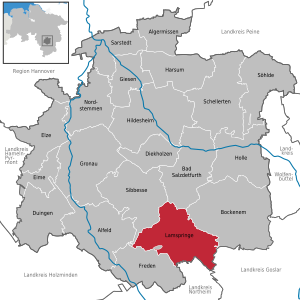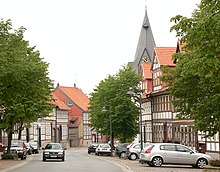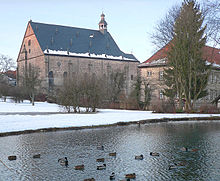Lamspringe
| coat of arms | Germany map | |
|---|---|---|

|
Coordinates: 51 ° 57 ' N , 10 ° 0' E |
|
| Basic data | ||
| State : | Lower Saxony | |
| County : | Hildesheim | |
| Height : | 211 m above sea level NHN | |
| Area : | 70.46 km 2 | |
| Residents: | 5592 (Dec. 31, 2019) | |
| Population density : | 79 inhabitants per km 2 | |
| Postal code : | 31195 | |
| Area code : | 05183 | |
| License plate : | HI, ALF | |
| Community key : | 03 2 54 044 | |
| LOCODE : | DE ZHY | |
| Community structure: | 13 towns | |
| Address of the municipal administration: |
Kloster 3 31195 Lamspringe |
|
| Website : | ||
| Mayor : | Andreas Humbert ( independent ) | |
| Location of the municipality of Lamspringe in the Hildesheim district | ||
Lamspringe is a unified municipality in the Hildesheim district in southern Lower Saxony . Lamspringe is a state-approved resort on the Heber . Lamspringe is a member of the Leinebergland region , a voluntary association of various cities and municipalities in southern Lower Saxony founded according to the Leader approach . The main town and administrative seat of the unified municipality is the hamlet of Lamspringe.
geography
location
The village of Lamspringe is located at the source of the Lamme between the Harplage mountain ranges in the northeast, Heber in the southeast and the Sackwald in the west. It is located in the four cities of Alfeld - Bad Salzdetfurth - Bockenem - Bad Gandersheim .
Major cities not far from Lamspringe are: Hanover (50 km) and Hildesheim (30 km) in the north and Göttingen (40 km) in the southeast. Another larger city is Goslar (30 km) in the east.
Community structure
- Harbarnsen (with Irmenseul )
- Lamspringe (with glassworks )
- Neuhof (with Ammenhausen and Wöllersheim )
- Sehlem (with Evensen )
- Woltershausen (with Hornsen, Graste and Netze )
history
Place name
Old names of the place are around 872 Lammespringensium , 873 Lammespring , 1138 Lamspringensi and in 1391 Lamme . The place name is a pre-Germanic river name in the river area of the upper and middle Leine . Baltic and Slavic generic names around “lom” for “break, windbreak”, “lomà” for “low spot in the field” and “lãma” for “puddle, pit” can be used as a basis.
Place and monastery foundation

The foundation of Lamspringe originally began with a Franconian mission station on the Hohe Schanze , 327 m above sea level, a few kilometers away . NN , in the Sackwald near Winzenburg . After that, the development of the area was directly linked to the establishment of the Lamspringe monastery . The monastery was first mentioned in 872 as a nunnery, the bishop Altfrid of Hildesheim the tithe ceded. The history of the monastery and thus also of the place was written down by a priest of the monastery in 1696 on the basis of original documents that are no longer available today.
According to a founding legend in the 16th century, the monastery was founded as a women's monastery in Lamspringe by Count Ricdag, a Saxon nobleman from the Immedinger family , at the source of the Lamme and his wife Imhildis. Their only daughter Ricburga was installed as the first abbess; Bishop Altfried von Hildesheim, the nephew of the founder, was involved in the establishment. According to the founding legend, the couple Ricdag went on a pilgrimage to Rome and received the remains of the martyr St. Hadrian from Pope Sergius II (844–847) .
development
The location west of the Harz Mountains between the protective mountain ranges of Harplage Heber and Harlath provided favorable settlement conditions for the town and monastery Lamspringe . There was also a pass nearby through which an old military and trade route ran. The settlement is supported by water and stone deposits. The later agricultural town of Lamspringe owes its development to the monastery, which required numerous workers as day laborers, servants, craftsmen and monastery servants. The settlement benefited from the upswing of the monastery, which was the richest monastery in the Hildesheim diocese until the 14th century and almost always a prosperous business enterprise over the centuries. Lamspringe became a center for cargo handling and brewing . This upward development continued after the monastery was dissolved in 1803.
During the Hildesheim collegiate feud between 1519 and 1523 between the Hochstift Hildesheim and the Duchy of Braunschweig , Lamspringe was burned down and the monastery looted. Since then, Lamspringe has belonged to Guelph territory for a good hundred years . In the Schmalkaldic War came in 1552 to an attack by the mercenary leader Vollrad Mansfeld , whose mercenaries nuns raped . The Thirty Years War hit Lamspringe hard. After the Battle of Lutter am Barenberge in 1626, mercenary troops looted the place and again burned dozens of houses. After the war, the monastery complex was in a catastrophic structural condition.
monastery
The lamspringe abbey was richly endowed in the foundation and in later centuries owned by donations. In the 12th century the monastery owned ten mills and tithe rights in 17 places. The possessions ranged from Seesen to Braunschweig and the Schaumburger Land . The focus of ownership was east of Lamspringe and in Ambergau . The cannon monastery experienced its heyday in the 12th and 13th centuries with around 180 nuns.
In 1643 Lamspringe and his monastery returned to Hildesheim Abbey after the Goslar recession from Guelph rule . The parish church, Lutheran since 1568, was not re-Catholicized . The bishop called English Benedictine monks who had been expelled from England to the dilapidated monastery . The monks animated the facility economically and spiritually. Starting in 1670, they built the three-aisled hall church of St. Hadrian and St. Dionysius in 21 years . In 1730 the new building of the abbey building, which was oversized for the time, with a 95 m long front facade followed. In 1803 the monastery was dissolved and converted into a royal domain.
20th century
In 1902 Lamspringe was connected to the Kreiensen - Hildesheim railway line , as a result of which further industrial companies settled.
1935–1938 Fritz Schaller built a Thingstätte in the former monastery garden.
The dropping of 10 high-explosive bombs on Lamspringe on February 20, 1944 claimed one person. However, there was only minor property damage.
In 1951 Lamspringe celebrated the 1100 year anniversary of the foundation of the monastery. There was a week-long festival event, which took place with a large participation of the population. The celebration had been postponed for four years because of the difficult post-war period. On the occasion of the anniversary, a local pharmacist wrote a “Lamspringe song” with five stanzas in 1951.
After the Second World War , the Lamspring companies increasingly suffered from the market in eastern Germany that had now ceased to exist . Meanwhile, the population sank to less than 3,000. Despite the closure of the railway line in the 1980s, the economy began to recover with reunification. Several companies in the metal and packaging industry settled in Lamspringe. The central location between A 7 and B 3 and the proximity to the B 64 played an important role here.
Community merger on November 1, 2016
The Samtgemeinde Lamspringe has converted to the unified community Lamspringe on 1 November 2016th Previously, Lamspringe was the administrative seat of the joint municipality.
politics
Lamspringe municipality
Municipal council
The municipal council consists of 16 councilors including the mayor:
(Status: local election September 11, 2016)
Municipal Mayor
The last honorary mayor was Lars Herr (SPD). His term of office ended on October 31, 2016. Due to the transformation of the joint municipality of Lamspringe into a unified municipality, the election of a full-time mayor on September 11, 2016 was necessary. Lars Herr did not run again. Andreas Humbert (independent, for the CDU) was able to prevail with 74.1% against the SPD candidate Katja Schoner for the election period that began on November 1, 2016.
Lamspringe core
Local council
The district of Lamspringe has its own local council consisting of nine council members including the local mayor:
(Status: local election September 11, 2016)
Local mayor
The local mayor of the core town of Lamspringe is Christian Krending (CDU). His deputy is Gitta Reckzeh (SPD).
coat of arms
The municipality was given the coat of arms on September 28, 1938 by the President of the Province of Hanover . The district administrator from Alfeld presented it on January 16, 1939.
| Blazon : "In red on green ground a jumping silver lamb , above it in the left corner of theshield a golden hop tendril with a silver leaf and golden fruit cone." | |
| Justification of the coat of arms: The redesign of the coat of arms for Lamspringe was based on the medieval coat of arms of the patch, which the abbot of the once important local monastery challenged the mayor in the 17th century without any justification, but with success. With the removal of the crook that he had inserted, the hop tendril was set as a symbol, pointing to the once so profitable hop growing in the district, which was the basis for the prosperity of the community. It has also been used as a symbol in the earlier seals and coats of arms of the patch. |
Culture and sights
Buildings
- Former monastery church “St. Hadrian and St. Dionysius ” as a three-aisled hall church , since 2009 a branch church of the Catholic parish of Bad Gandersheim .
- Abbey building of the monastery
- The church of the ev.-luth belonging to the parish of Hildesheimer Land-Alfeld. The community is called Sophienkirche after its founder, who came from the Münchhausen house and married into the Steinberg house . The building, consecrated in 1692, has pointed arched windows and a three-sided choir closure. The tower was added in 1819. The pulpit altar dates from the baroque period. Heinrich Schaper built the organ .
Parks
- Monastery park with the spring grotto of the Lammequelle . The 5.5 hectare garden, which used to belong to the monastery and where vegetables were grown, has been a public park since 1965.
Sports
Lamspringe has several sports clubs. The largest association TuSpo Lamspringe has a little over 600 members and offers football , gymnastics , handball , karate , table tennis and badminton . Other clubs are the Lamspringe Schützenklub von 1901 e. V., the Lamspringe tennis club , the Flenithigau riding club and the “Westharzer Skiclub e. V. ".
Regular events
- Lamspringer September since 1988. For one month there are events from various areas of culture and artistic entertainment in the abbey buildings of the former monastery. The event has now become a top-class national event. Prominent participants have already been Günter Grass , Martin Walser , Ephraim Kishon , Paul Kuhn as well as members of La Scala in Milan and the Berlin Philharmonic . The “Philosophical Salon” has been taking place in the monastery calendar room since 2003.
- Pilgrimage on the last weekend in August for the feast of Saint Oliver Plunkett, who was executed in 1681, as an annual event. In the monastery church “St. Hadrian and St. Dionysius ”there is a reliquary of this saint, whose bones were brought to Lamspringe in 1685 at the instigation of Abbot Maurus Corker .
- Threshing festival since 2007
Economy and Infrastructure
traffic
Lamspringe is not far from the A 7 , B 3 and B 64 . The nearest train stations are Bodenburg , Freden and Bad Gandersheim as well as Kreiensen , where there is a connection to the intercity network . The next airport is in Bad Gandersheim, the next airport is Hannover-Langenhagen .
tourism
Today tourism is of great importance for the state-approved resort on the Heber . In the 1990s, part of the old Kreiensen - Hildesheim railway line began to be converted into a cycle path over a total of 12 kilometers between Lamspringe and Bad Gandersheim . Sculptures by international artists were set up along the route, which gave the cycle path the name Lamspringe Sculpture Path . The conception of the path that connects the two former monasteries Lamspringe and Brunshausen (Bad Gandersheim) was developed by Ernst August Quensen.
media
Lamspringe does not have its own newspaper. The Hildesheimer Allgemeine Zeitung and the Alfelder Zeitung are available as daily newspapers in Lamspringe . The newspapers Kehrwieder and RuBS appear weekly .
education
Lamspringe has a primary school and a comprehensive school, which is housed in the building of the former secondary school. The closest high schools are in Hildesheim , Bad Gandersheim and Alfeld .
Personalities
Sons and daughters of the church
- Johannes Lotichius (1576–1650), legal scholar
- Friedrich Wilhelm Andreae (1822–1872), commercial school teacher, school director and owner of a privately run secondary school
- Ernst Bock von Wülfingen (1840–1899), Prussian major general
- Adolf Quensen (1851–1911), court decoration and church painter
- Josef Meyenberg (1891–1977), vocational school teacher and painter of northern German landscapes
- Kurt Heissmeyer (1905–1967), SS doctor
- Richard Mühe (1929–2009), watchmaker and physicist
- Ulrich Streeck (* 1944), psychiatrist, psychotherapist, sociologist and social psychologist
- Lothar Hampe (* 1946), politician (CDU)
- Christine Heipertz-Hengst (* 1947), sports scientist, sports therapist, riding trainer and non-fiction author
- Micha Kloth (* 1952), painter and graphic artist
- Andreas Arlt (* 1966), musician
- Michael Arlt (* 1969), musician
People connected to the community
- Maurus Corker (1636–1715), English Benedictine, persecuted, abbot of the Lamspringe monastery
- Jobst Heinrich Lessen (around 1700), picture carver, he created the carvings for the furnishings in the Lamspringe monastery church
- Friedrich Münchmeyer (1807–1882), neo-Lutheran theologian, was pastor in Lamspringe from 1840 to 1851
- August Husemann (1833–1877), pharmacist and chemist, was a. a. Pharmacist in Lamspringe
- Alfred Lüntzel (1833–1910), lawyer and attorney at the Reichsgericht. In 1853 he took up his first practical position as an auditor in Lamspringe
- Wilhelm Keitel (1882–1946), Army officer (from 1940 General Field Marshal) and from 1938 to 1945 Chief of the High Command of the Wehrmacht, was rewarded by Adolf Hitler in October 1944 with 246 hectares of forest property in Lamspringe
- Heinz Julius Mackenthun (1884–1941), entrepreneur and politician (DDP), was the owner of the North German trading company Mackenthun & Co. in Lamspringe
- Herbert Backe (1896-1947), politician (NSDAP), he took over in 1931 took over the NSDAP local group leadership in Lamspringe
- Fritz Schaller (1904–2002), architect, built the Thingstätte in the former cloister garden in Lamspringe from 1935–1938
- Gert Pinkernell (1937–2017), Romance studies and literary scholar, professor at the Bergische Universität Wuppertal, grew a. a. in Lamspringe
literature
- Hans-Oiseau Kalkmann: The lamb - biography of a river. Gebrüder Gerstenberg Verlag, Hildesheim 2010, ISBN 978-3-8067-8746-7 .
- Ernst Andreas Friedrich : If stones could talk. Volume 2, Landbuch-Verlag, Hannover 1992, ISBN 3-7842-0479-1 .
- H.-W. Böhme: Lamspringe. In: Guide to Prehistoric and Protohistoric Monuments. Volume 49. Part II Excursions, Mainz 1981, ISBN 3-8053-0548-6 .
- Axel Christoph Kronenberg: Lamspringe Monastery. Alfeld 2006, ISBN 978-3-9811183-0-8 .
Web links
- Website of the municipality of Lamspringe
- Website of the parish of Lamspringe Graste Netze Neuhof
- Bike path to the Kunst-Lamspringe
Individual evidence
- ↑ State Office for Statistics Lower Saxony, LSN-Online regional database, Table 12411: Update of the population, as of December 31, 2019 ( help ).
- ^ Jürgen Udolph (research): The "place name researcher". In: website NDR 1 Lower Saxony. Archived from the original on December 2, 2016 ; accessed on August 1, 2018 .
- ↑ The history of Lamspringe. In: Website of the municipality of Lamspringe. Retrieved September 22, 2017.
- ↑ Lower Saxony State Chancellery (Ed.): Law on the reorganization of the Lamspringe community, Hildesheim district . Lower Saxony Law and Ordinance Gazette (Nds. GVBl.). No. 19/2015 . Hanover November 12, 2015, p. 305 ( digitized version ( memento from July 5, 2019 in the Internet Archive ) [PDF; 464 kB ; accessed on July 5, 2019] p. 7).
- ^ Results of the Lamspringe municipal council election. In: Website of the municipality of Lamspringe. Retrieved September 22, 2017 (PDF; 1.4 MB).
- ↑ Mayoral election on September 11, 2016. In: NDR website. Retrieved September 22, 2017.
- ↑ a b The local council of Lamspringe. In: Website of the municipality of Lamspringe. Retrieved September 22, 2017.
- ^ A b Wilhelm Barner : Coat of arms and seal of the Alfeld district . Rebinding. Lax GmbH & Co. KG, Hildesheim 1998 ( digitized version of the text part of the first edition from 1940 [PDF; 10.0 MB ; accessed on June 10, 2019]).
- ^ Wilhelm Mithoff: Art monuments and antiquities in Hanover. Volume 3, 1875, p. 194.
- ↑ CV and exhibitions - Vita Micha Kloth. In: Micha Kloth's website. Retrieved July 31, 2018 .
- ↑ a b World-class musicians who are down to earth. In: website Leinetal24. December 23, 2014, accessed July 31, 2018 .








